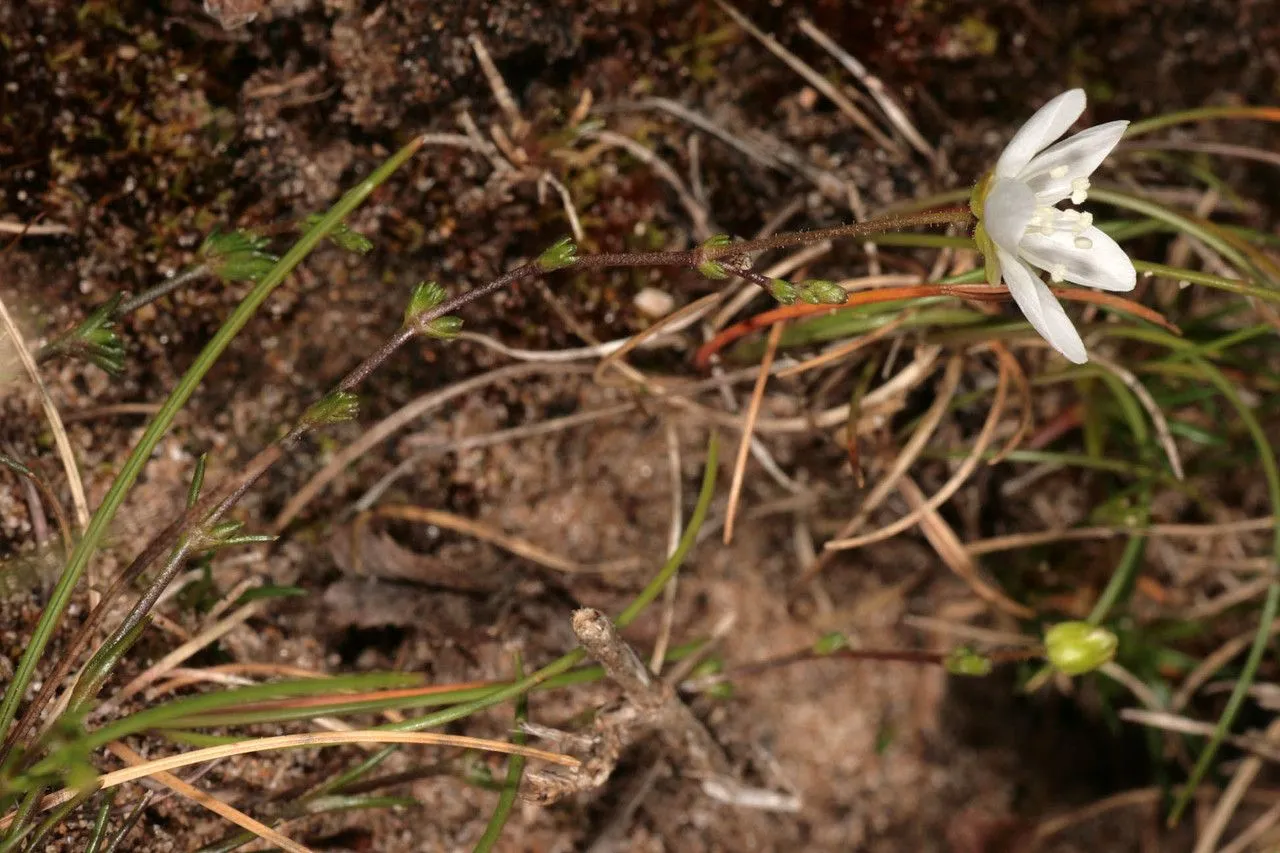
Author: (L.) Fenzl
Bibliography: Vers. Darstell. Alsin.: 18 (1833)
Year: 1833
Status: accepted
Rank: species
Genus: Sagina
Vegetable: False
Observations: Subarctic America to NC. & NE. U.S.A., Europe to Siberia and Caucasus
Knotted pearlwort, known scientifically as Sagina nodosa, is an interesting and delicate species belonging to the Caryophyllaceae family. First described thoroughly in 1833 by (L.) Fenzl in the publication “Vers. Darstell. Alsin.: 18,” this plant has secured a notable place in the world of botany due to its wide distribution and unique characteristics.
This perennial herb can be found spanning across a broad range of habitats, including Subarctic America, the northern central and northeastern regions of the United States, and extending across Europe to Siberia and the Caucasus. Its adaptability to various climates makes it an intriguing subject of study for botanists and plant enthusiasts alike.
Knotted pearlwort thrives in well-drained soils, often inhabiting rocky terrains and moist mossy areas. Its delicate stems, which can sprawl or grow erect, are adorned with small, opposite leaves that form a lush green carpet. The plant’s name, both common and scientific, alludes to its distinctive knotted appearance; tiny, white to greenish-white flowers emerge in a somewhat clustered, knot-like pattern.
The flowers of Sagina nodosa are especially noteworthy for their understated beauty. Generally blooming in the warmer months, these petite blossoms have slender petals that radiate a simple yet elegant charm. As a member of the Caryophyllaceae family, the knotted pearlwort shares affiliations with well-known plants such as carnations and pinks, allowing it to be easily identified by its botanical traits.
In terms of ecological importance and usage, knotted pearlwort is a vital component of its native ecosystems. It provides ground cover that helps in soil stabilization and supports various small invertebrates. Additionally, its subtle presence adds a delicate aesthetic to the natural landscapes it inhabits, making it a cherished find for nature lovers.
Despite its unassuming appearance, Sagina nodosa is a testament to the diversity and adaptability of plant life. Whether observed in the wild or studied in a botanical setting, the knotted pearlwort continues to captivate with its tenacity and intrinsic elegance.
Deu: knotiges mastkraut
Dan: knude-firling
Eng: knotted pearlwort
Fra: sagine noueuse
Nld: sierlijke vetmuur
Nno: knopparve, knoppsmåarve
Nob: knopparve, knoppsmåarve
Swe: knutnarv
Sme: uddosárremas
Cym: corwlydd clymog, corwlyddyn clymog, troellig clymog
Gla: mongán glúineach
En: Knotted pearlwort
Be: Гарыца вузлаватая
Cs: Úrazník uzlovitý
Da: Knude-firling
Nl: Sierlijke vetmuur
Et: Sõlmine kesakann
Fi: Nyylähaarikko
Fr: Sagine noueuse
De: Knotiges Mastkraut
Hu: Csomós zöldhúr
Is: Hnúskakrækill
It: Sagina nodosa
Se: Uddosárremas
Nb: Knopparve, Knoppsmåarve
Nn: Knopparve, Knoppsmåarve
Pl: Karmnik kolankowaty
Gd: Mongán glúineach
Sv: Knutnarv
Uk: Моховинка вузлувата
Cy: Corwlyddyn clymog, Corwlydd Clymog, Troellig Clymog
Taken Jan 1, 1900 by EOL − Ecomare, Sytske Dijksen (cc-by-nc)
Taken Jan 1, 1900 by EOL − Encyclopedia of Life (cc-by-nc-sa)
Taken Jul 29, 2021 by Groupe Botanique de Bruxelles (cc-by-sa)
Taken Jul 28, 2018 by Rinusz (cc-by-sa)
Taken Jul 28, 2018 by Rinusz (cc-by-sa)
Taken Jul 19, 2020 by Jaak Pärtel (cc-by-sa)
Taken Jul 29, 2021 by Groupe Botanique de Bruxelles (cc-by-sa)
Taken Sep 23, 2022 by Jona Lumo (cc-by-sa)
Taken May 26, 2022 by Amandine Deligey (cc-by-sa)
Taken Jul 28, 2018 by Rinusz (cc-by-sa)
Taken Aug 19, 2022 by Frank Sundermeyer (cc-by-sa)
Taken Jan 1, 1900 by EOL − Encyclopedia of Life (cc-by-nc-sa)
Taken Jan 1, 1900 by EOL − Encyclopedia of Life (cc-by-nc-sa)
Taken Jan 1, 1900 by EOL − Encyclopedia of Life (cc-by-nc-sa)
Taken Aug 6, 2011 by Tela Botanica − Marie PORTAS (cc-by-sa)
Taken Sep 8, 2015 by EOL − Jakob Fahr (cc-by-nc)
Taken Jan 1, 1970 by Photoflora – L’Abbé COSTE (©)
Taken Sep 15, 2007 by Photoflora – Jean-Luc TASSET (©)
Taken Aug 15, 2007 by Photoflora – Jean-Luc TASSET (©)
Taken Oct 15, 2003 by Photoflora – Jean-Luc TASSET (©)
Taken Jan 1, 1800 by Tela Botanica − Daniel MATHIEU (cc-by-sa)
Taken Jan 1, 1900 by EOL − Encyclopedia of Life (cc-by-nc)
© copyright of the Board of Trustees of the Royal Botanic Gardens, Kew.
© copyright of the Board of Trustees of the Royal Botanic Gardens, Kew.
© copyright of the Board of Trustees of the Royal Botanic Gardens, Kew.
Growth habit: Forb/herb
Ph maximum: 7.0
Ph minimum: 6.5
Light: 8
Atmospheric humidity: 8
Soil nutriments: 4
Soil salinity: 2
Family: Myrtaceae Author: (F.Muell.) K.D.Hill & L.A.S.Johnson Bibliography: Telopea 6: 402 (1995) Year: 1995 Status:…
Family: Rubiaceae Author: Pierre ex A.Froehner Bibliography: Notizbl. Bot. Gart. Berlin-Dahlem 1: 237 (1897) Year:…
Family: Sapindaceae Author: Koidz. Bibliography: J. Coll. Sci. Imp. Univ. Tokyo 32(1): 38 (1911) Year:…
Family: Asteraceae Author: A.Gray Bibliography: Pacif. Railr. Rep.: 107 (1857) Year: 1857 Status: accepted Rank:…
Family: Fabaceae Author: Medik. Bibliography: Vorles. Churpfälz. Phys.-Ökon. Ges. 2: 398 (1787) Year: 1787 Status:…
Family: Aspleniaceae Author: (Cav.) Alston Bibliography: Bull. Misc. Inform. Kew 1932: 309 (1932) Year: 1932…